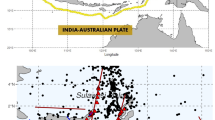Abstract
Several space-time statistical models are constructed based on both classical empirical studies of clustering and some more speculative hypotheses. Then we discuss the discrimination between models incorporating contrasting assumptions concerning the form of the space-time clusters. We also examine further practical extensions of the model to situations where the background seismicity is spatially non-homogeneous, and the clusters are non-isotropic. The goodness-of-fit of the models, as measured by AIC values, is discussed for two high quality data sets, in different tectonic regions. AIC also allows the details of the clustering structure in space to be clarified. A simulation algorithm for the models is provided, and used to confirm the numerical accuracy of the likelihood calculations. The simulated data sets show the similar spatial distributions to the real ones, but differ from them in some features of space-time clustering. These differences may provide useful indicators of directions for further study.
Similar content being viewed by others
References
Akaike, H. (1974). A new look at the statistical model identification, IEEE Trans. Automal Control, AC-19, 716–723.
Daley, D. J. and Vere-Jones, D. (1988). An Introduction to the Theory of Point Processes, Springer, New York.
Fedotov, S. A. (1965). On regularities in distribution of strong earthquakes in Kamchatka, Kurile Islands and northeastern Japan, Trudy Inst. Fiz. Zemli, 36(203), 66–93.
Fletcher, R. and Powell, M. J. D. (1963). A rapidly convergent descent method for minimization, Comput. J., 6, 163–168 (in Russian).
Guo, Z. and Ogata, Y. (1997). Statistical relations between the parameters of aftershocks in time, space and magnitude, Journal of geophysical Research, 102, 2857–2873.
Hawkes, A. G. (1971). Point spectra of some mutually exciting point processes, J. Roy. Statist. Soc. Ser. B, 33, 438–443.
Kagan, Y. Y. (1991). Likelihood analysis of earthquake catalogues, Journal of geophysical Research, 106, 135–148.
Kagan, Y. Y. and Jackson, D. D. (1991). Seismic gap hypothesis: Ten years after, Journal of geophysical Research, 96, 21419–21431.
Kagan, Y. Y. and Jackson, D. D. (1995). New seismic gap hypothesis: Five years after, Journal of geophysical Research, 100, 3943–3959.
Kagan, Y. Y. and Knopoff, L. (1978). Statistical study of the occurrence of shallow earthquake, Geophysical Journal of the Royal Astronomical Society, 55, 67–86.
Kagan, Y. Y. and Knopoff, L. (1980). Spatial distribution of earthquakes: the two-point correlation function, Geophysical Journal of the Royal Astronomical Society, 62, 303–320.
Kanamori, H. and Anderson, D. L. (1975). Theoretical basis of some empirical relation in seismology, Bull. Seismol. Soc. Amer., 65, 1073–1096.
Kowalik, J. and Osborne, M. R. (1968). Methods for Unconstrained Optimization Problems, American Elsevier, New York.
McCann, W. R., Nishenko, S. P., Sykes, L. R. and Krause, J. (1979). Seismic gaps and plate tectonics: Seismic potential for major boundaries, Pure and Applied Geophysics, 117, 1082–1147.
Mogi, K. (1968). Sequential occurrences of recent great earthquakes, Journal of Physics of the Earth, 16, 30–36.
Musmeci, F. and Vere-Jones, D. (1992). A space-time clustering model for historical earthquakes, Ann. Inst. Statist. Math., 44, 1–11.
Nishenko, S. P. and Sykes, L. R. (1993). Comment on “Seismic gap hypothesis: Ten years after” with Reply by Jackson, D. D. and Kagan, Y. Y., Journal of geophysical Research, 98, 9909–9920.
Ogata, Y. (1981). On Lewis' simulation method for point processes, IEEE Trans. Inform. Theory, IT-30, 23–31.
Ogata, Y. (1987). Long term dependence of earthquake occurrences and statistical models for standard seismic activity (in Japanese): Suri Zisin Caku (Mathematical Seismology) II (ed. M. Saito), ISM Cooperative Research Report 3. 115–124, Inst. Statist. Math., Tokyo.
Ogata, Y. (1988). Statistical models for earthquake occurrences and residual analysis for point processes, J. Amer. Statist. Assoc., 83(401), 9–27.
Ogata, Y. (1989). Statistical model for standard seismicity and detection of anomalies by residual analysis, Tectonophysics, 169, 159–174.
Ogata, Y. (1992). Detection of precursory seismic quiescence before major earthquakes through a statistical model, Journal of geophysical Research, 97, 19845–19871.
Ogata, Y. (1993). Space-time modeling of earthquake occurrences, Bulletine of the International Statistical Institute, 55, Contributed papers, Book 2, 249–250.
Ogata, Y. and Abe, K. (1991). Some statistical features of the long term variation of the global and regional seismic activity. International Statistical Review, 59, 139–161.
Ogata, Y. and Katsura, K. (1988). Likelihood analysis of spatial inhomogeneity for marked point patterns, Ann. Inst. Statist. Math., 40, 29–39.
Ogata, Y., Utsu, T. and Katsura, K. (1995). Statistical features of foreshocks in comparison with other earthquake clusters, Geophysical Journal International, 121, 233–254.
Ohtake, M., Matumoto, T. and Latham, G. V. (1977). Seismicity gap near Oaxaca, southern Mexico as a probable precursor to a large earthquake, Pure and Applied Geophysics, 115, 375–385.
Rathbun S. L. (1993). Modeling marked spatio-temporal point patterns, Bulletine of the International Statistical Institute, 55, Book 2, 379–396.
Rathbun S. L. (1996). Asymptotic properties of the maximum likelihood estimator for spatio-temporal point processes, J. Statist. Plann. Inference, 51, Special issue on Spatial Statistic, Part II, 55–74.
Utsu, T. (1961). Statistical study on the occurrence of aftershocks. The Geophysical Magazine, 30, 521–605.
Utsu, T. (1969). Aftershocks and earthquake statistics (I): some parameters which characterize an aftershock sequence and their interaction, Journal of the Faculty of Science, Hokkaido University, Ser. VII (geophysics), 3, 129–195.
Utsu, T. (1972). Large earthquakes near Hokkaido and the expectancy of the occurrence of a large earthquake off Nemuro, Report of the Coordinating Committee for Earthquake Prediction, 7, 1–13 (in Japanese).
Utsu, T. and Seki, A. (1955). Relation between the area of aftershock region and the energy of the main shock, Zisin (Journal of the Seismological Society of Japan) 2nd Ser. ii, 7, 233–240 (in Japanese with English summary).
Yamanaka, Y. and Shimazaki, K. (1990). Scaling relationship between the number of aftershocks and the size of the main shock, J. Phys. Earth, 38, 305–324.
Author information
Authors and Affiliations
About this article
Cite this article
Ogata, Y. Space-Time Point-Process Models for Earthquake Occurrences. Annals of the Institute of Statistical Mathematics 50, 379–402 (1998). https://doi.org/10.1023/A:1003403601725
Issue Date:
DOI: https://doi.org/10.1023/A:1003403601725




